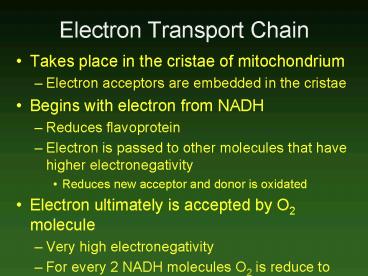Electron Transport Chain - PowerPoint PPT Presentation
1 / 10
Title:
Electron Transport Chain
Description:
Electron is passed to other molecules that have higher electronegativity ... Causes muscles to ache after workout. Anaerobic conditions. Why Fermentation ... – PowerPoint PPT presentation
Number of Views:1242
Avg rating:3.0/5.0
Title: Electron Transport Chain
1
Electron Transport Chain
- Takes place in the cristae of mitochondrium
- Electron acceptors are embedded in the cristae
- Begins with electron from NADH
- Reduces flavoprotein
- Electron is passed to other molecules that have
higher electronegativity - Reduces new acceptor and donor is oxidated
- Electron ultimately is accepted by O2 molecule
- Very high electronegativity
- For every 2 NADH molecules O2 is reduce to 2H2O
2
Electron Transport 2
- Each new acceptor requires that the electron be
at a slightly lower energy state - Energy is siphoned off of the electrons in small
increments - The energy is used by the acceptor molecules to
change conformation - All are proteins except Q (ubiquinone) is lipid
3
Close-up of Cristae
- Many electron acceptors used released energy to
pump an H proton into the intermembrane space - Gradient of H is formed outside of cristaes
4
Oxidative phosphorylation
- ATP is actually synthesized by enzyme ATP
synthase - Many copies embedded in cristae
- Hydrogen gradient needs to reach equilibrium
- H can only pass through ATP synthase molecule
- Passage of H turns molecule like a water wheel
- ATP is generated by enzyme action
5
Net ATP Production
- Glycolysis 2 ATP, Krebs 2 ATP, Electron
Transport oxidative phosphorylation 34 ATP - Total of 38 ATP/glucose
6
Fermentation
- Used when oxygen is not available as electron
acceptor - Not as efficient as oxidative phosph.
- In humans, only 2 ATP are produced by
fermentation - Accumulation of waste molecules
- Sometimes can be used later as energy source
- Type of fermentation is known by waste product
7
Types of Fermentation
- Alcohol fermentation
- Results in ethanol production
- Performed by bacteria and fungi
- Lactic acid fermentation
- Used by animals
- Results in lactate formation
- Causes muscles to ache after workout
- Anaerobic conditions
8
Why Fermentation
- Pyruvate is dividing point of two systems
- If O2 is available pyruvate enters mitochondrium
- If O2 level is low Pyruvate stays in cytosol and
undergoes fermentation
9
Macromolecules and Respiration
- Many types of macromolecules can be used as a
source for respiration - Fats and proteins are important
- They enter pathway at various point
10
Regulation of Respiration
- Very complex regulation
- Feedback inhibition of ATP or Citrate can stop
early stages of reactions - Allows cell to produce ATP when needed

